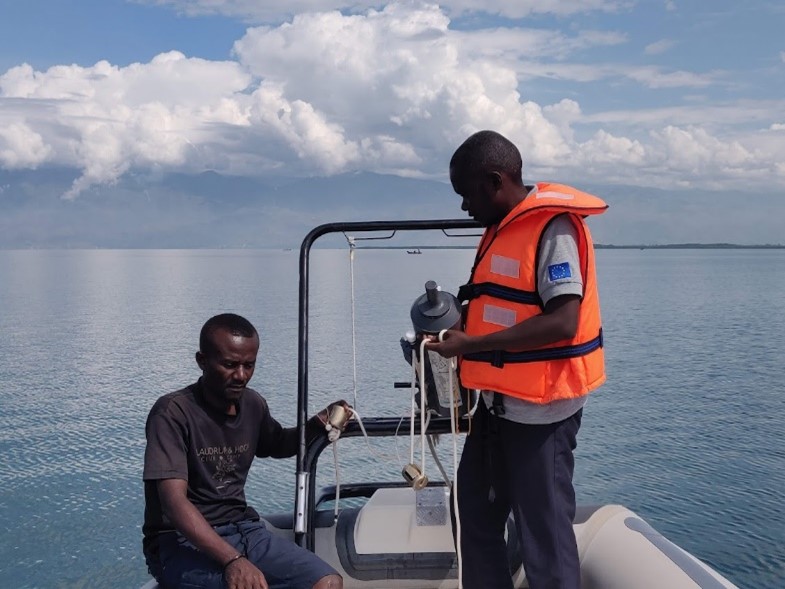
Situated in the heart of East Africa and extending across 32,900 km², Lake Tanganyika is Africa’s second largest lake. It harbors a diverse array of biodiversity, including some 500 endemic species, highlighting its global ecological importance. Located among five riparian countries — Tanzania, the Democratic Republic of Congo (DRC), Burundi, Zambia, and including the catchment area in Rwanda — Lake Tanganyika serves as an essential natural resource, holding 18% of the world's fresh surface water and playing a pivotal role in supporting the economies and livelihoods of the surrounding communities.
Challenges
The ecological wealth of Lake Tanganyika is endangered by multifaceted human-induced pressures. Population growth, catchment area degradation, erosion, overfishing, invasive species, urban pollution, and the impacts of climate change are all contributing to an increasingly precarious state of the lake. Notably, climate change has been a catalyst for fluctuating lake levels, which have led to recurrent flooding events since 2020. Aggravating ecological conditions signal a profound need for a nuanced, cross-sectoral, and regional approach to management of the lake basin , a challenge that prompted the formation of the Lake Tanganyika Authority (LTA) in 2003. Tasked with the lake's management, the LTA oversees efforts to mitigate adverse human impacts and strives for the sustainable use of Lake Tanganyika's resources.
Objectives
In response to the pressing challenges faced by Lake Tanganyika, the European Union (EU), along with a contribution from the Wallonia authorities (Belgium), initiated the Lake Tanganyika Water Management (LATAWAMA) project in 2019 with a total budget of 7.4 million euros. This project, executed in partnership with the Belgian development agency, ENABEL, and the LTA, aims at tackling pollution, elevating water quality, and ensuring the sustainable management of this invaluable ecosystem. The LATAWAMA project is focused on interventions outlined in the LTA's action plan to preserve Lake Tanganyika.
Detailed activities undertaken to achieve these objectives are:
- Water-Quality Monitoring Network Enhancement: A water-quality monitoring network was initiated to span across limnology, fisheries, meteorology, soil erosion, and biodiversity. This effort led to the creation of four laboratories and support for research centers in the riparian countries, laying the foundation for a thorough environmental surveillance system. It provides a critical, data-driven basis for the sustainable management of Lake Tanganyika.
- Targeted Pollution Control Measures: In the towns of Bujumbura (Burundi), Kigoma (Tanzania), Uvira (DRC), Mpulungu (Zambia), and Rusizi (Rwanda), specific interventions have been launched to combat pollution. These efforts aim to improve wastewater treatment, solid waste management, and watershed protection by addressing pollution at its source and thereby improving water quality.
- Infrastructure and Capacity Enhancement: The project has notably improved infrastructure through activities including the rehabilitation of sludge drying beds at Bujumbura's wastewater treatment plant, which were no longer operational, and the enhancement of Kigoma’s solid waste collection process. In Bujumbura, the project's support extended to the wastewater treatment plant’s laboratory through the provision of analytical equipment and reagents, as well as the digitalization of the wastewater connection network. For Kigoma, the project provides comprehensive equipment support, including training, repair of equipment, fuel support, and the purchase of containers, catering to various levels of operational needs.
Future Directions and EU Commitment
The activities at Lake Tanganyika, a cornerstone in the EU's strategy for transboundary water cooperation, underscore the EU’s commitment to fostering regional stability, peace, and security. In November 2023, this commitment was further solidified with a second phase of funding amounting to 31 million euros for the TAKIWAMA project, titled “Tanganyika and Kivu Water Management”.
TAKIWAMA builds upon the foundations set by LATAWAMA by enhancing five key areas:
- Strengthening the environmental monitoring network, with the addition of water quantity and biological monitoring;
- Institutional support through the improvement of legal frameworks for water management and encouraging adherence to the UNECE Water Convention on transboundary waters;
- Collaborative scientific research between European and African entities to achieve a comprehensive understanding of the lakes’ dynamics;
- Advancing pollution control with integrated management of wastewater, solid waste, and watershed protection, employing a circular economy approach;
- Enhancing transport governance on Lake Tanganyika, focusing on safety, security, and communications improvements.
- Project locations
- Bujumbura, BurundiKigoma, TanzaniaUvira, Democratic Republic of the CongoMpulungu, ZambiaRusizi, Rwanda
- Overall budget
- €7 400 000
- EU contribution
- €6 900 00093.2% of the overall budget
- Project website
- Lake Tanganyika Water Management
